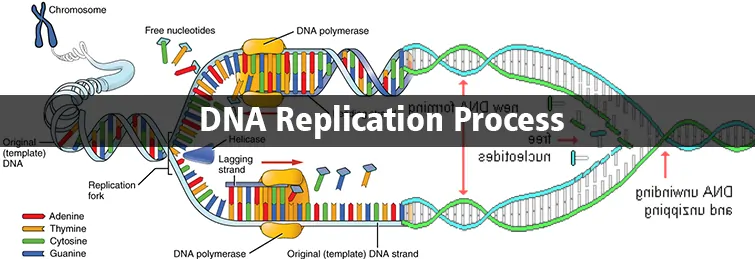Definition -DNA replication is a fundamental process in studying DNA and is essential for cell growth and multiplication. Understanding the process of DNA replication is crucial for students studying biology, and that's where EssayCorp's biology assignment help service can assist.
The role of DNA polymerase in the definition of DNA replication is to add nucleotides to the 3’-OH group of the RNA primer, and it also helps remove any incorrect base pairs.
This process is crucial for incorporating correct, complementary base pairs on the template strands. Termination is the final stage of the replication process.
A termination signal like Ter signals guides the joining of the leading and lagging strands in the opposite direction.
The three prerequisites for any living entity are Feeding, Locomotion, and reproduction, and so does the living cell. Each living cell needs food. To get in search of food, it needs to locomote. To produce its next generation or offspring, it needs energy. So it needs food.
The living cell divides and produces its offspring by mitotic division.As cells divide, they ensure that both new daughter cells receive an equal share of the cytoplasm and nuclear content. In this way, each cell ends up with an equal amount of DNA so that they can function properly.
DNA Replication in Prokaryotes and Eukaryotes
DNA replication takes place in both prokaryotes and eukaryotes. Though the entire replication mechanism is the same in both prokaryotes and eukaryotes, the machinery involved in the tool differs in prokaryotes and eukaryotes.
In cell division, the DNA double helix unwinds, and the two strands split apart. Then, when the cell creates new DNA molecules, it relies on each existing strand to act as an essential template for the process.
The entire cell division was divided into karyokinesis and Cytokinesis. During karyokinesis, nuclear division occurs; during Cytokinesis, the cytoplasm divides. Moreover, genetic information has to be passed on to the next generation with great precision.
This process is called DNA replication. DNA replication is the process by which a cell makes an exact copy of its DNA. This process is essential for cell growth, development, and reproduction.
DNA REPLICATION MECHANISM
What are the three steps of replication?
During the S phase of the cell cycle, cells undergo DNA replication through a series of carefully coordinated steps to ensure that the process is accurate and reliable.
The process of DNA replication can be broken down into three key stages: initiation, elongation, and termination. The first stage, initiation, involves the action of helicase enzymes that unwind the DNA helix to create a replication fork. This opens up the double-stranded DNA molecule, allowing the template strand to be copied.
The next step, elongation, is where the new DNA strand is synthesized. This process involves DNA polymerase enzymes that add nucleotides to the growing DNA chain.
The polymerase enzyme reads the template strand and adds complementary nucleotides to the new DNA strand in a 5' to 3' direction. The leading strand is synthesized continuously, while the lagging strand is synthesized in small, discontinuous Okazaki fragments.
Finally, termination marks the end of the replication process. This step involves the completion of the new DNA strand and rejoining the two strands of the DNA helix. Once the replication is complete, each new cell will have an exact copy of the original cell's DNA.
Understanding the DNA replication steps is crucial for many fields of study, including biology, genetics, and medicine. For students struggling with biology assignments related to DNA replication steps, Essaycorp offers expert biology assignment help.
Their team of highly qualified professionals can provide students with case study assignment help, ensuring they understand the complex mechanisms involved in DNA replication. With Essaycorp's assistance, students can master the intricacies of DNA replication to excel in their academic endeavors.
The mechanism of replication can be staged into three phases:
- Initiation
- Elongation
- Termination
Initiation: The DNA strand comprises two strands Leading and lagging. Initiation of replication begins on the Leading strand at the ori site. Ori site or origin of the image is a particular site on a DNA strand with a specific sequence responsible for initiation.
It leads to the formation of Preprimosome. About six proteins named dnaA, dnaB, dnaC, Gyrase, SSBP, and H4 are involved in this process. The dnaA protein binding occurs on both sides of the ori C region.
DnaB and dnaC help in the complex primosome formation where dnaB helps recognize a single strand after the activity of helicase and also helpful in activating primase enzymes (dnaC—this is the gene that codes for enzymes Primase).
The enzyme Gyrase allows the strand to rotate around the other, whereas the SSBP (Single strand Binding protein) prevents the re-annealing of separated DNA strands.
Once initiation is done, elongation or extension of the strand takes place.
Elongation: The main event occurring in the extension process is the formation of a replication fork which proceeds in the opposite direction from the oriC region. This type of replication, where two strands are separated and move in opposite directions, is known as a Bi-directional Replication.
A replication fork is formed when a pair of replicated segments come closer and join with the non-replicated components. The powerful enzymes in this stage are DNA polymerase, Primase, and ligase.
What is the role of DNA polymerase in DNA replication?
RNA primer oins at the region of the initiation complex, and the enzyme polymerase helps add nucleotides to the 3’-OH group of RNA primer. The daughter strand is synthesized in a 5’-3’ direction, which is anti-parallel to the parental strand.
During the process of elongation, DNA polymerase also helps in removing the mismatch or incorrect base pair. This activity of DNA polymerase is known as exonuclease activity. This process is essential for incorporating correct, complementary base pairs on the template strands.
The leading strand of DNA is synthesized continuously by the DNA polymerase, as it extends from 3' to 5'. In contrast, the lagging strand undergoes extension in the opposite direction, creating separate fragments called Okazaki fragments. Once the elongation process is complete, the next crucial step is the termination of the strands.
Termination: This is the final stage of the replication process.
During this stage, the joining of the leading and lagging strands, which move in opposite directions, occurs by following an anti-parallel path.
A proper termination signal like the Ter signal guides this process.
To conclude, DNA replication is one of the unique properties to make exact copies of itself, contributing to cell growth and multiplication. If the replication is beyond the control of the cell, then it eventually leads to a tumor.
DNA Structure and Replication:
Understanding the Basics DNA or Deoxyribonucleic Acid is the genetic material that contains the blueprint of life. DNA replication is a fundamental process that enables cells to reproduce and pass on genetic information to their offspring.
In this article, we will discuss the structure of DNA, where DNA replication occurs, and the study of DNA.
The DNA structure comprises a double helix design, wherein two strands of nucleotides intertwine with each other in a twisted manner.
Each nucleotide comprises a sugar molecule, a phosphate group, and a nitrogenous base. The nitrogenous bases in DNA are Adenine (A), Thymine (T), Guanine (G), and Cytosine (C), which pair up in a specific way (A with T and G with C).
Hydrogen bonds between the complementary base pairs hold the DNA molecule together, facilitating DNA study. Cells replicate DNA before division through the process known as DNA replication.
It involves the unwinding of the double helix and the separation of the two strands. Each strand then serves as a template for synthesizing a new complementary strand.
In DNA replication, the semi-conservative process ensures that each newly formed DNA molecule consists of one strand from the parent molecule and one newly synthesized strand. This helps maintain the accuracy of genetic information in subsequent generations of cells.
The replication of DNA is a complex process that involves several enzymes and proteins. Where Does DNA Replication Take Place? DNA replication occurs in eukaryotic cells' nuclei and prokaryotic cells' cytoplasm.
Conclusion -
At EssayCorp, we understand that biology assignment help can be challenging, so we offer expert assistance to students struggling.Our experienced writing team possesses a strong understanding of biology and is capable of delivering top-notch assignment solutions within the given deadline.
We also offer case study assignment help to help students gain a deeper understanding of DNA replication and other biological concepts. So, if you need assistance with your biology assignments, contact EssayCorp today.



